Photo / Video News & Reviews
Want To Capture Great Video Of Marine Life? Relax And Breathe Easy With Your Video Camera
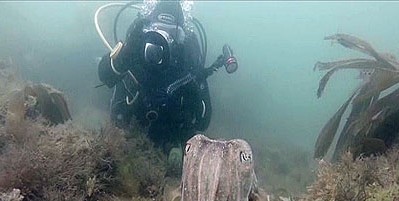
I have just finished a two day one-to-one video course in Falmouth with a young lady who wanted to know how to get the best from her video camera. She had been taking good still photos before, but had not been getting on too well with the video option on her camera.
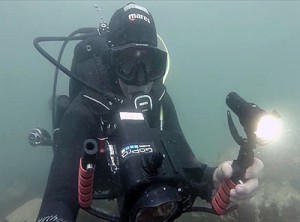 We spent the morning looking at all the best possible settings for the camera and talked about how to effectively utilise her video light. Ninety nine percent of the time I prefer to use a single hand-held light, which gives me complete control over its direction and distance from the subject. This means having my camera in one hand and the light in the other. It’s quite a tricky thing to do and good buoyancy control is essential.
We spent the morning looking at all the best possible settings for the camera and talked about how to effectively utilise her video light. Ninety nine percent of the time I prefer to use a single hand-held light, which gives me complete control over its direction and distance from the subject. This means having my camera in one hand and the light in the other. It’s quite a tricky thing to do and good buoyancy control is essential.
The afternoon saw our first dive and we decided to stay shallow in a sandy bay dotted with small clusters of rock and kelp to practice filming a short ‘diver’ sequence we had previously story-boarded. We would be too shallow to use our video lights to any great effect and so decided to use available light only. The visibility was very poor as we had previously had some bad weather and the sky was overcast giving a grey flat light underwater. On top of that there were several other divers in the area helping to stir up the sand. Never mind – it was good practice for videoing in low visibility conditions, using wide angle lenses and getting close to the subject.
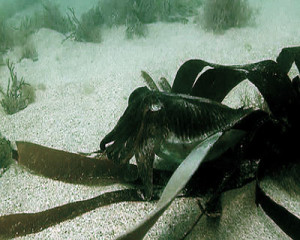
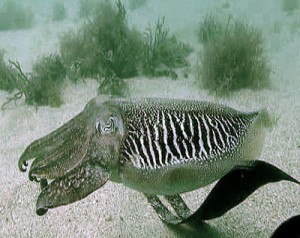 Having successfully completed our story-board shots, we looked around for something else to film. A small cuttlefish was hiding under a small loose piece of kelp and had turned itself black trying to blend in. We slowly edged closer and as soon as the cuttlefish knew it had been seen it eased out of hiding and immediately changed colour to match the surrounding sand.
Having successfully completed our story-board shots, we looked around for something else to film. A small cuttlefish was hiding under a small loose piece of kelp and had turned itself black trying to blend in. We slowly edged closer and as soon as the cuttlefish knew it had been seen it eased out of hiding and immediately changed colour to match the surrounding sand.
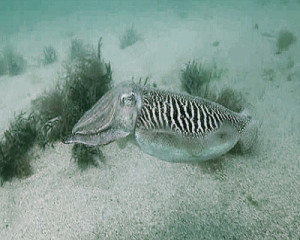 One of the key factors to successfully videoing cuttlefish, or any other shy animal, is don’t frighten it. Try not to make it think you are a predator. Avoid sudden or quick movements as getting good video or even photos of marine life is not just about the technicalities of using your camera. Patience and a little knowledge about your subject can bring great rewards. There are occasions when you get lucky and just happen to be in the right place at the right time, when taking a great shot is as easy as could be. In addition to slow movements, try very gentle and even breathing. Try to avoid holding your breath in order to get closer and then exhaling explosively in desperation to take another breath. Gentle and slow….and then there will come a singular moment when you know the animal is relaxed with you and the show is on.
One of the key factors to successfully videoing cuttlefish, or any other shy animal, is don’t frighten it. Try not to make it think you are a predator. Avoid sudden or quick movements as getting good video or even photos of marine life is not just about the technicalities of using your camera. Patience and a little knowledge about your subject can bring great rewards. There are occasions when you get lucky and just happen to be in the right place at the right time, when taking a great shot is as easy as could be. In addition to slow movements, try very gentle and even breathing. Try to avoid holding your breath in order to get closer and then exhaling explosively in desperation to take another breath. Gentle and slow….and then there will come a singular moment when you know the animal is relaxed with you and the show is on.
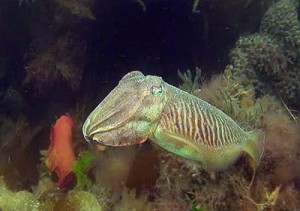 The cuttlefish eased away from us and backed into the thicker kelp for better cover. The temptation to chase can be there, but that really never works as all you end up doing is putting the animal into full flight mode.
The cuttlefish eased away from us and backed into the thicker kelp for better cover. The temptation to chase can be there, but that really never works as all you end up doing is putting the animal into full flight mode.
Although we lost sight of it, we knew it was quite relaxed and probably not too far away. It was in fact hovering low down in the kelp near the sand keeping an eye on us. Slowly moving forward we came eye to eye with the cuttlefish and began to let it know we were quite harmless. We were then able to spend the next thirty minutes with it before moving away and letting it be free of us.
I have to say that for me, this is what diving is all about, gentle and close interactions with marine animals and capturing those moments on video.
We reviewed the dive video later in the afternoon and discussed how to improve shots and techniques for any future edit. We put the clips together with some music and a brief narration which can be seen below.
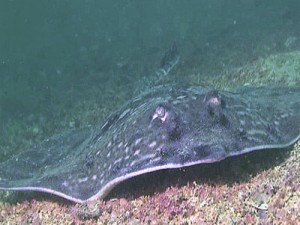
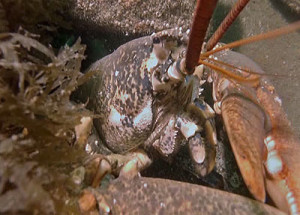 The next day we had two deeper dives and so were able to make use of our lights to bring out the hidden colour of the animals we filmed. Again, by approaching animals slowly, we were able to get close and not frighten anything away. It’s an incredible marine world around our coasts and by taking time to explore and observe with your camera, the true wonders of our wildlife will present themselves to you.
The next day we had two deeper dives and so were able to make use of our lights to bring out the hidden colour of the animals we filmed. Again, by approaching animals slowly, we were able to get close and not frighten anything away. It’s an incredible marine world around our coasts and by taking time to explore and observe with your camera, the true wonders of our wildlife will present themselves to you.
[youtube id=”XNzt4xZ-Tmg” width=”100%” height=”400px”]
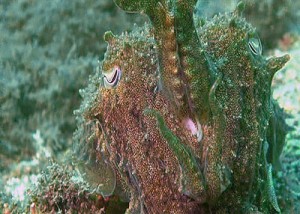 For more information on cuttlefish, click here.
For more information on cuttlefish, click here.
If you would like to know more about underwater videoing and join a course, contact Jeff at uwv@scubaverse.com or jeffgoodman@supanet.com.
Blogs
Diver Discovering Whale Skeletons Beneath Ice Judged World’s Best Underwater Photograph
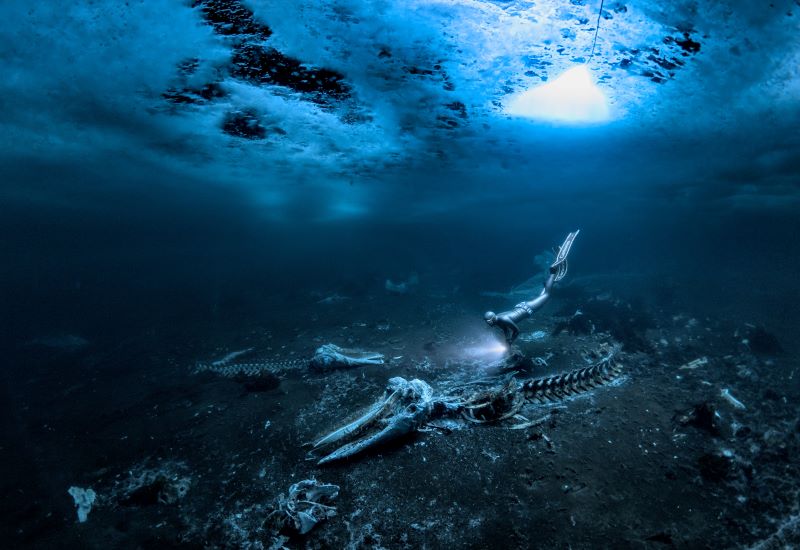
An emotive photograph showing a freediver examining the aftermath of whaling sees
Alex Dawson from Sweden named Underwater Photographer of the Year 2024. Dawson’s
photograph ‘Whale Bones’ triumphed over 6500 underwater pictures entered by underwater
photographers from around the world.
“Whale Bones was photographed in the toughest conditions,” explains chair of judging
panel Alex Mustard, “as a breath-hold diver descends below the Greenland ice sheet to bear
witness to the carcasses. The composition invites us to consider our impact on the great
creatures of this planet. Since the rise of humans, wild animals have declined by 85%. Today,
just 4% of mammals are wildlife, the remaining 96% are humans and our livestock. Our way
needs to change to find a balance with nature.”
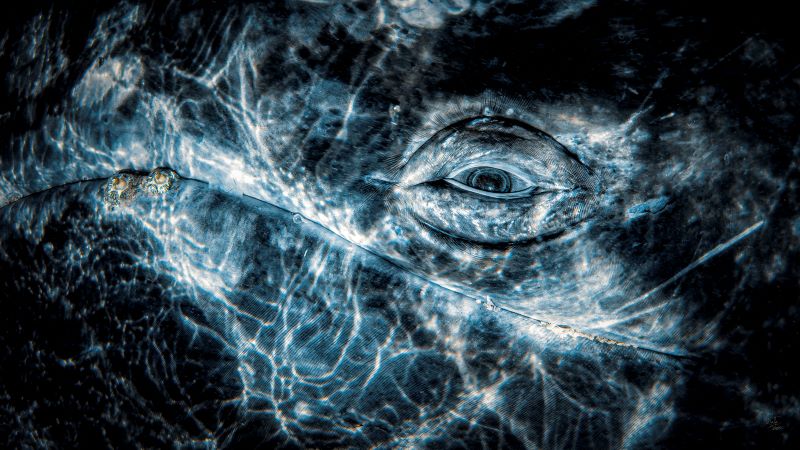
Photo: Rafael
Fernandez Caballero
Whales dominated the winning pictures this year with Spanish photographer Rafael
Fernandez Caballero winning two categories with his revealing photos of these ocean giants:
a close up of a grey whale’s eye and an action shot of a Bryde’s whale engulfing an entire bait
ball, both taken in Magdalena Bay, Baja California, Mexico. Fernandez Caballero took ‘Grey
Whale Connection’ while drifting in a small boat, holding his camera over the side in the water
to photograph the curious whale. ‘The End Of A Baitball’ required Fernandez Caballero to dive
down and be in exactly the right place at the moment the whale lunged. “The photo shows
the high speed attack,” he said, “with the whale engulfing hundreds of kilograms of sardines
in one bite — simply unforgettable to see predation on such a scale.”
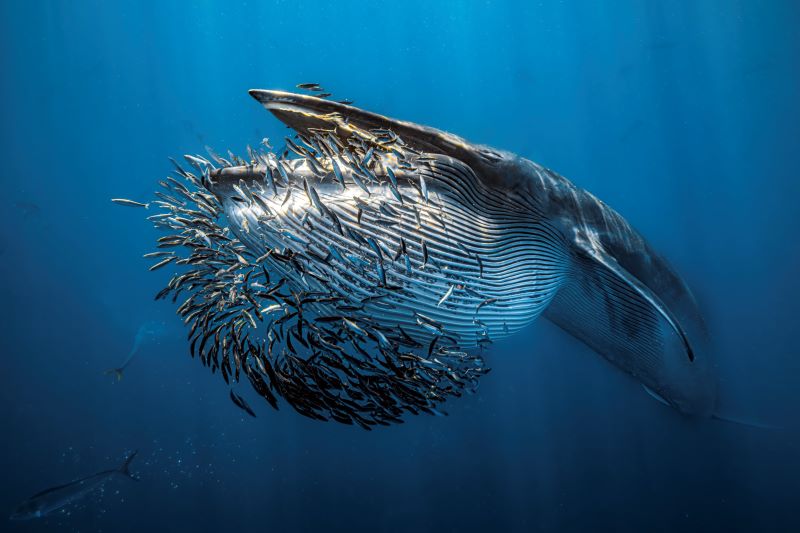
Photo: Rafael
Fernandez Caballero
Lisa Stengel from the United States was named Up & Coming Underwater Photographer of the Year 2024 for her image of a mahi-mahi catching a sardine, in Mexico. Stengel used both a very fast shutter speed and her hearing to catch the moment. “If you listen there’s an enormous amount of sound in the ocean,” she explained. “The action was too fast to see, so I honed in on the sound of the attacks with my camera to capture this special moment.”
“It is such an exciting time in underwater photography because photographers are capturing such amazing new images, by visiting new locations and using the latest cameras,”
commented judge Alex Mustard. “Until this year I’d hardly ever see a photo of a mahi mahi,
now Lisa has photographed one hunting, action that plays out in the blink of an eye.”
The Underwater Photographer of the Year contest is based in the UK, and Jenny Stock,
was named as British Underwater Photographer of the Year 2024 for her image “Star
Attraction”, which finds beauty in species of British wildlife that are often overlooked.
Exploring the west coast of Scotland, Stock explained “in the dark green depths my torch
picked out the vivid colours of a living carpet of thousands of brittle stars, each with a
different pattern. I was happily snapping away, when I spotted this purple sea urchin and I
got really excited.”
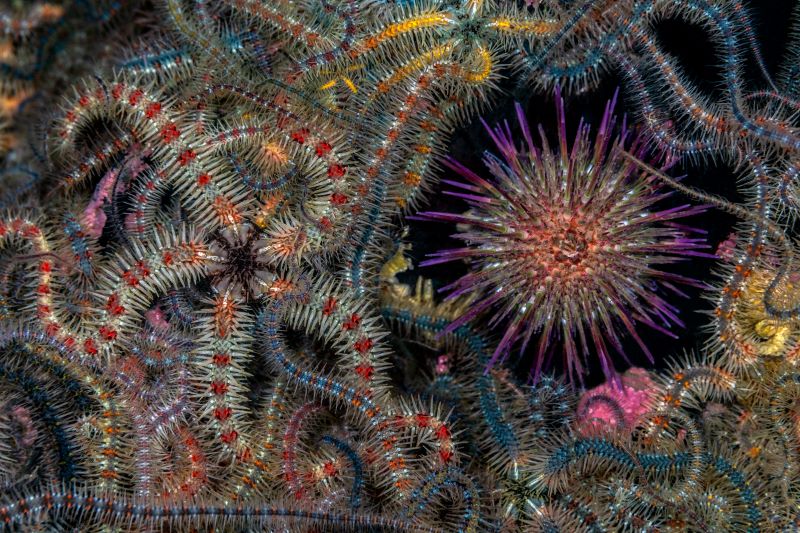
Photo: Jenny Stock
In the same contest, Portuguese photographer, Nuno Sá, was named ‘Save Our Seas
Foundation’ Marine Conservation Photographer of the Year 2024, with his photo ‘Saving
Goliath’, taken in Portugal. Sá’s photo shows beachgoers trying to save a stranded sperm
whale. The picture gives us hope that people do care and want to help the oceans, but also
warns us that bigger changes are needed. “The whale had been struck by a ship and its fate
was sealed,” explains Sá. “An estimated 20,000 whales are killed every year, and many more
injured, after being struck by ships-and few people even realise that it happens.”
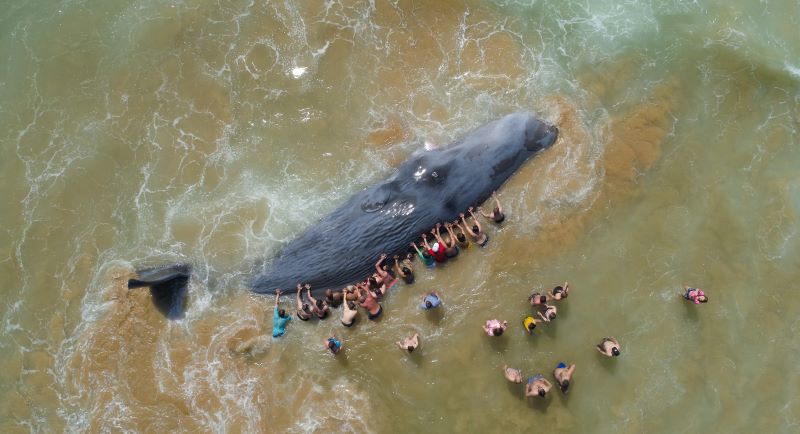
Photo: Nuno Sá
More winning images can be found at www.underwaterphotographeroftheyear.com.
About Underwater Photographer of the Year
Underwater Photographer of the Year is an annual competition, based in the UK, that celebrates photography beneath the surface of the ocean, lakes, rivers and even swimming pools, and attracts entries from all around the world. The contest has 13 categories, testing photographers with themes such as Macro, Wide Angle, Behaviour and Wreck photography, as well as four categories for photos taken specifically in British waters. The winners were announced in an award ceremony in Mayfair, London, hosted by The Crown Estate. This year’s UPY judges were experienced underwater photographers Peter Rowlands, Tobias Friedrich and Dr Alexander Mustard MBE.
Header image: Underwater Photographer of the Year 2024 winner Alex Dawson
News
World’s Best Underwater Photographers Unveil Breathtaking Images at World Shootout 2023
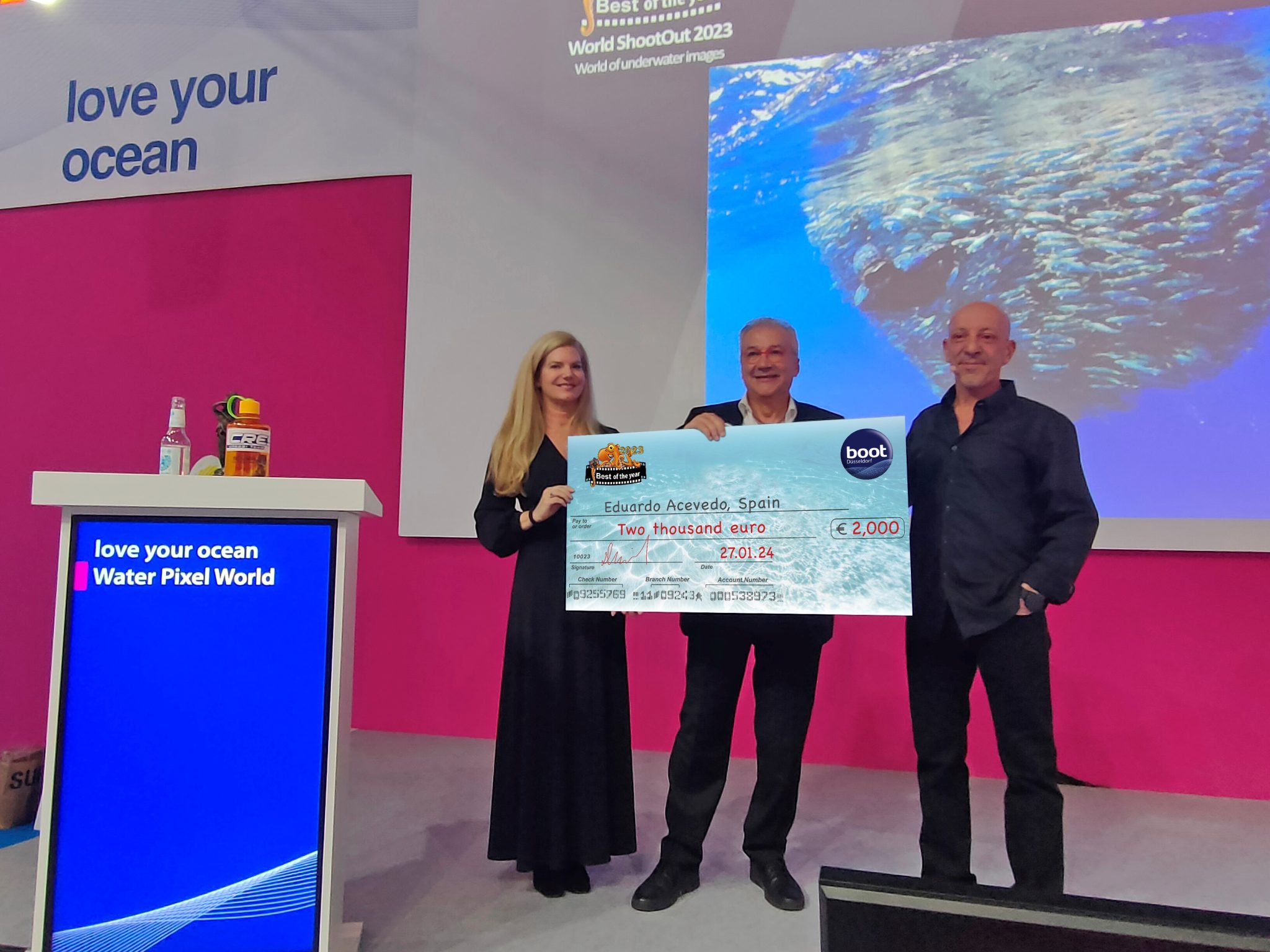
The winners of the prestigious World Shootout 2023 underwater photography competition were announced at this year’s BOOT Show, captivating audiences at the world’s largest diving and water sports exhibition in Dusseldorf, Germany. Hundreds of photographers from 54 countries competed across nine categories, pushing the boundaries of creativity and technical skill.
Grand Prize Winners
- Picture of the Year: Spanish photographer Eduardo Acevedo “secured” the top Honor with the prestigious prize the “boot Dusseldorf Director’s Prize, earning an Andromeda statuette and a €2,000 cash prize.
- Best 5 Images Portfolio: Luc Rooman from Belgium triumphed in this category, winning a dream 4-week diving trip for two to Papua New Guinea, valued at $18,900.
- Amateur Photographer: Alexandra Ceurvorst from the USA impressed the judges with her talent, taking home the 1,000 € cash prize award.
Celebrating Diversity and Innovation
This year’s competition saw 11,680 entries from 964 photographers, showcasing a remarkable spectrum of skills and perspectives. From the intricate wonders of Macro photography to the beauty of “Black Water”, the “Underwater Fashion” category added a touch of artistry and innovation, while the ever-important ” Environmental & Conservation” category served as a powerful reminder of the need to protect these fragile ecosystems.
Looking Ahead: AI and Ocean Conservation
World Shootout founder and producer David Pilosof unveiled an exciting addition for the 2024 competition: this year the Environmental category will be focusing on the impact of plastic on our oceans and future.
This category will embrace the potential of AI or other editing software as a tool to amplify the conservation message.
Entrants will submit campaigns of three original underwater photographs dealing with plastic pollution, along with their final AI assistance processing. This innovative approach encourages artistic expression while raising awareness about a critical environmental issue.
Explore the Stunning Collection
Discover the complete album of competition entries by clicking here.
For Low-resolution photos of finalist entries in eight categories, click here.
-

 News3 months ago
News3 months agoHone your underwater photography skills with Alphamarine Photography at Red Sea Diving Safari in March
-

 News3 months ago
News3 months agoCapturing Critters in Lembeh Underwater Photography Workshop 2024: Event Roundup
-

 Marine Life & Conservation Blogs2 months ago
Marine Life & Conservation Blogs2 months agoCreature Feature: Swell Sharks
-

 Blogs2 months ago
Blogs2 months agoMurex Resorts: Passport to Paradise!
-

 Blogs2 months ago
Blogs2 months agoDiver Discovering Whale Skeletons Beneath Ice Judged World’s Best Underwater Photograph
-

 Marine Life & Conservation2 months ago
Marine Life & Conservation2 months agoSave the Manatee Club launches brand new webcams at Silver Springs State Park, Florida
-

 Gear Reviews3 months ago
Gear Reviews3 months agoGear Review: Oceanic+ Dive Housing for iPhone
-

 Gear Reviews2 weeks ago
Gear Reviews2 weeks agoGEAR REVIEW – Revolutionising Diving Comfort: The Sharkskin T2 Chillproof Suit




